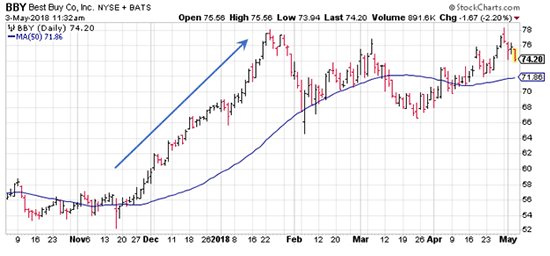One of my 10 "Trading Commandments" is "Short sellers are usually a bull's best friend." That's because short interest, especially when there's too much of it, often provides the fuel for strong rallies.
It sounds counterintuitive, but it's true. How does that work?
It's fascinating, it has everything to do with human nature, and, best of all, it can be one of the most wildly profitable events for any stock.
You just need to make sure you're on the right side of it, and with Best Buy Co. Inc. (NYSE: BBY), this is your big chance.
[mmpazkzone name="in-story" network="9794" site="307044" id="137008" type="4"]
"Investing 201": How a Short Squeeze Works
We know that an investor who's bearish on a stock can short it by selling it in the hopes that he can buy back the shares at a lower price and pocket the difference.
Short interest is the sum of all shorted shares on a stock that have not been covered or closed out by buying back the stock.
"PLAY THE BOOKIE" and collect ultra-fast potential gains of 300% in the next week. Details here...
The problem for the short sellers - "shorts" - arises when the stock moves against their expectations (i.e., goes up). That's when short sellers are forced to "cover" their losing positions on a stock.
This results in unusually strong buying volume - known as a "short squeeze" - that drives a stock price higher.
The result is typically that a stock makes an unusually fast move higher. And it's this type of move that generates oversized profits... IF you can spot the short squeeze before it happens.
One of the best ways to spot upcoming moves - and it's one I use regularly for my Seismic Profits Alert subscribers - is to look at a stock's typical price action around earnings. Most will tell you what a stock typically does after earnings.
But I like to look at what a stock does heading into its report, because you'll often see a pattern of strength or weakness as traders anticipate the report.
Finding high short interest on a stock that tends to rally into earnings is a doubly bullish play in my book, especially if you leverage the expected pop with options.
Such is the case right now with Best Buy; I just recommended a play on these shares to my Seismic Profits Alert subscribers. My subscribers have had the chance to rake in plenty on similar and related technical setups in shares before, like 153.59% and 276.47% on FCAU, and 100% and 131.85% on CHRW. You can go here to learn a little bit more about how my service works.
Best Buy reports earnings on May 24, a little less than three weeks from today. Last quarter, the stock rallied about 11% in the three weeks leading up to earnings. The quarter before that, the stock gained 4% in the prior three weeks.
Currently, Best Buy is pulling back after a five-week, 17% rally. And we saw some short sellers close their positions during this run-up.
But short interest remains high. In fact, around 30 million BBY shares remain short, which represents a whopping 17% of the stock's float.
Normally, I consider 6% of the float the threshold for a juicy short-squeeze opportunity, but this setup, with much better than double the short interest I like to see, is basically irresistible; there's plenty of "shorting fuel" for another rally.
Now, with earnings on the horizon and its 50-day moving average pointing higher and poised to provide support, I see Best Buy ready to embark on another pre-earnings rally. And with high short interest, any uptick could start the shorts covering their positions.
How powerful can a Best Buy rally be?
Well, look at what the stock did after reporting earnings in November 2017. The shares rocketed nearly 50% in a little more than two months. But what made the rally go was the shorts covering 10 million shares of losing bets. This massive unwinding of short positions added substantial buying pressure that propelled the shares to an all-time high.

This Easy-to-Follow Blueprint Could Make You $15,000 Richer
America's No. 1 Pattern Trader used to be an average Joe scraping to get by. He never graduated from college, and he spent most of his career as a Home Depot customer service rep.
He didn't want to be stuck at a job he didn't like until he was 80 - so he taught himself how to trade. He found he had a knack for it, and he became richer than he ever thought possible.
Then he invented his patent-pending "Money Calendar," and he knew it could change people's lives.
Now, for the first time ever, he's revealing all his trading secrets and strategies - so you can amass a fast fortune for yourself.
Step by step, click by click, he'll guide you through setting up your account - and show you how to set up a series of take-it-to-the-bank payouts of $605... $822... $1,190... or $2,830... every single week.
There's no guesswork involved, and the best part is, it'll only take you 10 minutes per day! Click here now to start this once-in-a-lifetime journey...
Follow Money Morning on Facebook, Twitter, and LinkedIn.
About the Author
Chris Johnson (“CJ”), a seasoned equity and options analyst with nearly 30 years of experience, is celebrated for his quantitative expertise in quantifying investors’ sentiment to navigate Wall Street with a deeply rooted technical and contrarian trading style.



